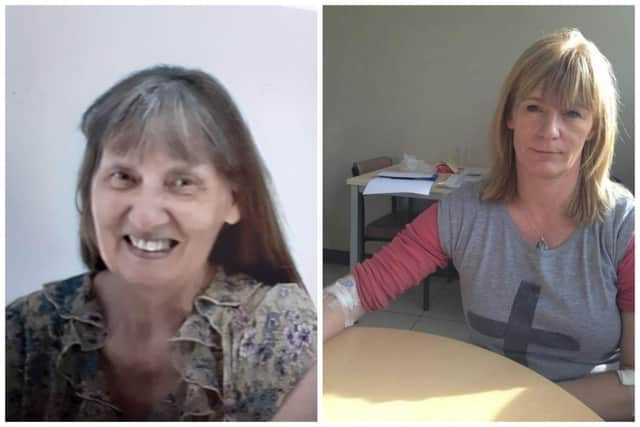Ticks Scotland: Sufferer says Lyme disease is a 'hidden epidemic' of most 'insidious, destructive and life-destroying disease'
Elizabeth Parker had only spent four months in her idyllic cottage in the Scottish Highlands where she had chosen to retire with her Bernese Mountain dog Bonnie when she noticed a rash that resulted in a life-changing disease.
After being misdiagnosed with shingles in 2020, weeks after she noticed the reaction on her abdomen, the former teacher went on to develop chronic Lyme disease (LD) – a tick-borne illness – two years later.
Advertisement
Hide AdAdvertisement
Hide AdHer diagnosis comes at a time where tick numbers are on the rise, with a growing concern about the lack of awareness of the diseases they bring with them.


Public Health Scotland figures showed LD cases more than doubled from 207 in 2012 to 529 in 2021.
By 2019, Scotland was the UK’s LD hot spot, with cases “three times more common” than estimates.
And GP database figures presented at the NorthTick 2023 conference in Inverness in May indicated cases of LD north of the border could now be about five times higher than is currently recorded.


Symptoms and lack of awareness
Ms Parker said she has serious concern over a lack of awareness and reliable testing of the infection when turning to the NHS for help.
Describing her symptoms, she said: “My right knee was so weak I had to buy support straps and walk with a stick. I was so weak I had to bring my mattress downstairs as I couldn't climb up stairs.
“I had fever-like symptoms and severe fatigue, where I just had to sleep. You just can't fight it.”


The 70-year-old, who has now moved to Edinburgh with Bonnie to ensure the pair are at less risk from ticks, said she believed she was bitten by an infected one while out walking around her former dream Highland home.
Advertisement
Hide AdAdvertisement
Hide AdDespite her rash with two circles mimicking a bullseye rash – a classic sign of LD – she said she was misdiagnosed by multiple doctors before realising, two years later, she had chronic LD.
"This disease is a hidden epidemic,” she said. "Chronic LD is not recognised, acknowledged or even accepted as existing by our health professionals enough.
"There are thousands suffering from it; family life shattered, jobs lost, relationships destroyed, sanity questioned, savings plundered as we pour money into alternative treatments because the care we should be receiving isn't there.


“I'm off to order yet more supposedly effective natural products tried and recommended by fellow sufferers in online LD Facebook groups; a measure we have to resort to as we grasp at anything to relieve the torture of this most insidious, destructive and life-destroying disease.”
It’s not always a rash
Not everyone who is infected develops a bullseye rash, however, said LD sufferer Lorraine Murray.
The Montrose mother and former Army fitness instructor was left housebound, needing to use a wheelchair and ended up having her gall bladder removed after being bitten by an infected tick.
“It has destroyed my life, it really has,” she said.
The 52-year-old, who said she believed she contracted the bacterial infection while walking her dog Jazz in Kinnaber Woods in Montrose in August 2014, said what began as flu symptoms soon worsened into muscle spasms, dizziness and headaches.
She had been shaving her legs when she was in the shower and knocked the tick off, not realising it had been attached to her body.
Advertisement
Hide AdAdvertisement
Hide Ad“Not everyone will get a bullseye rash or even notice one,” she said. “People shouldn’t just presume if they don’t get a rash, they haven’t been infected. It is important to be aware of this.”
By nine months, Mrs Murray could not walk and needed to use a wheelchair. She underwent tests in hospital, but was discharged without a diagnosis, though the illness continued for the next 18 months.
After she watched a TV documentary about LD, the penny dropped. Two years after she was bitten, she was given a clinical diagnosis of Lyme disease from the NHS in 2016.
A year later Mrs Murray wasn’t responding to treatment and it turned out the tick that bit her was carrying other infections, which included babesia microti.
She then developed chronic cholecystitis, swelling and irritation of the gallbladder, and had to have the organ removed in 2018.
Mrs Murray has been left with a central nervous system dysfunction caused by untreated Lyme disease and co-infections. Some nine years later, she still has to take a wide range of tablets to help manage her condition.
Awareness
Both women are part of a group pushing the Tick-borne Illness Campaign Scotland, which, in 2017, put forward a petition urging the Scottish Government to improve testing and treatment for LD and associated tick-borne diseases by ensuring that medical professionals are better equipped.
Ritti Soncco, a medical anthropologist who completed a PhD on chronic LD at the University of Edinburgh in 2020, said there was a strong, developing community of patients across the country who were suffering with the disease and who felt “abandoned by the NHS”.
Advertisement
Hide AdAdvertisement
Hide Ad"You have an entire health care system being built by the patients themselves because they are not being heard by the NHS,” she said. "There is certainly a desire for collaboration, a desire to make sure that more attention is being paid to their plight.
"There needs to be more awareness. These people are really, really sick.”
The standard treatment for LD when a patient is said to be infected is 21 days of taking the antibiotic doxycycline.
Ms Soncco said if symptoms continue, the disease could then be misdiagnosed as conditions such as chronic fatigue.
Experts say prevention is the best way to ward off the disease, urging people to avoid dense vegetation, tuck their trousers into their socks and use tick repellents.
They said the higher number of cases in Scotland could be explained by “its wetter climate and popularity as a hiking destination”.
The Scottish Government said to promote awareness of LD it led a “Find a tick, remove it quick” campaign during May, which saw posters and information cards in pharmacies in Scotland.
This summer it plans to follow with posters in GP practices, leisure centres, libraries and community centres.
Comments
Want to join the conversation? Please or to comment on this article.